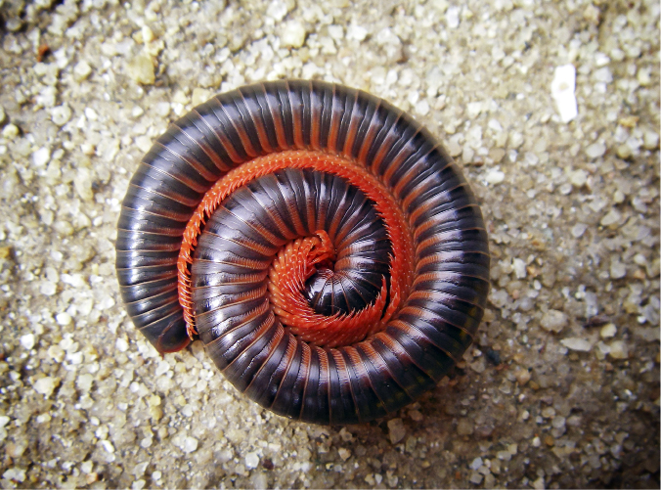
Editor’s Note: This article was reprinted with permission from Pinto & Associates.
Although it’s sometimes called a “thousand-legger,” the millipede has many fewer legs, usually from 60 to 180+, depending on the species. One way that it can be distinguished from a centipede is that a millipede has two pairs of very short legs per body segment, while a centipede has one pair of longer legs per segment.
Both add more legs with each of several molts. Although newborn millipedes have only six legs to start with, don’t confuse them with insects. Millipedes are arthropods but they belong to the class Diplopoda.
There are many species of millipedes with a wide range in size when fully grown. Our common species range from 1/16 to 4½ inches (2-115 mm) long. Most are wormlike and round in cross-section (centipedes are not). Color is usually shiny dark brown but some are lighter and some have bright colors. Antennae are short.
Unlike predaceous centipedes, millipedes are scavengers, feeding mainly on decaying plant material (occasionally damaging seedlings) or dead insects. Millipedes are found outside in damp areas: under leaves, in mulch or compost, in grass clippings or dense lawn thatch, under logs or other debris around foundations. They can build up to large numbers when moisture and other conducive conditions exist.

PEST POTENTIAL. Millipedes will migrate, sometimes in very large numbers, if their outside sites become too dry, too wet or too crowded. Migrations are short-lived and occur most often in the spring and fall. Millipedes will enter buildings if they find openings, usually on the shady side of structures. Indoors, they end up in damp areas such as basements, crawlspaces or laundry rooms, but don’t survive long in drier indoor air.
Unlike centipedes, millipedes move slowly but when disturbed or threatened, they can curl up into a tight coil (centipedes can’t) with their head in the center. Some millipedes excrete foul-smelling defensive fluid, which may cause skin irritation. They don’t bite or sting or damage anything indoors.
Control of millipedes begins outside by drying out and cleaning up conditions around the foundation. Lawn management, including dethatching and letting grass dry out during the day, discourages millipedes. Pest-proofing of doors and openings around the foundation, along with perimeter pesticide treatments, if necessary, will help prevent movement indoors.
KEY POINTS TO REMEMBER. Millipedes are outdoor perimeter pests found in damp areas with decaying vegetation. They can become occasional invaders when they get into structures, but don’t survive long unless conditions are very damp. Indoor control by a PMP, other than pest-proofing and a broom, is rarely needed.
The authors are well-known industry consultants and co-owners of Pinto & Associates.

Explore the May 2018 Issue
Check out more from this issue and find your next story to read.
Latest from Pest Control Technology
- SiteOne Hosts 2024 Women in Green Industry Conference
- Veseris Celebrates Grand Reopening of the Miami ProCenter
- Rollins' 2024 Second Quarters Revenues up 8.7 Percent YOY
- Fleetio Go Fleet Maintenance App Now Available in Spanish
- German Cockroach Control Mythbusting
- Total Pest Control Acquires Target Pest Control
- NPMA Workforce Development Shares Hiring Updates
- Certus Acquires Jarrod's Pest Control





